![]()
![]()
![]()
Use LEFT and RIGHT arrow keys to navigate between flashcards;
Use UP and DOWN arrow keys to flip the card;
H to show hint;
A reads text to speech;
53 Cards in this Set
- Front
- Back
- 3rd side (hint)
|
Sketching |
Drawing without instruments |
|
|
|
HB, F, H are examples of what? |
Types of soft lead used for sketching |
|
|
|
True or false: the pencil point should be pushed across the paper while sketching |
False, pushing can cause tearing |
|
|
|
How to sketch lines? |
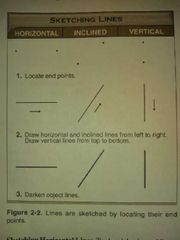
|
|
|
|
How do you sketch a circle? |

|
|
|
|
What are pictorial drawings? |
Drawings that look like a "picture" because they convey a sense of perspective and realism of the object being viewed. These may be shaded. |
|
|
|
What is an axonometric drawing? |
A pictorial drawing showing 3 sides of an object with horizontal and vertical dimensions drawn to scale and containing no true view of any side. |
|
|
|
What are the 3 basic types of axonometric drawings? |
Dimetric, trimetric and isometric |
|
|
|
What is a dimetric drawing? |

A drawing with 2 axes drawn on equal angles and the third containing either more or less degrees |
|
|
|
What is a trimetric drawing? |
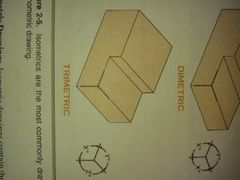
A drawing with all 3 axes drawn at different angles |
|
|
|
What is an isometric drawing? |
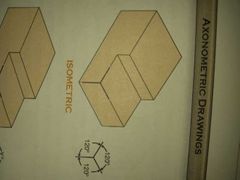
A drawing with the axes 120 degrees apart, the most common pictorial drawing type used. |
|
|
|
What is a true view? |
Is a view in which the lines of sight are perpendicular to the surface |
|
|
|
Because of the skewed side what do circles or drilled holes appear as on isometric surfaces? |
Ellipses |
|
|
|
Review isometric drawing |
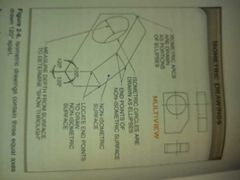
|
|
|
|
What is an oblique drawing? |
Is a pictorial drawing that shows one surface of an object as a true view. All other surfaces are distorted by the angle of receding |
|
|
|
What are the 2 types of oblique drawings? |
Cabinet and cavalier |
|
|
|
What is a cabinet drawing? |
An oblique drawing with receding lines drawn to 1/2 the scale of the true view |
|
|
|
What are cavalier drawings? |
Oblique drawing with receding lines drawn to the same scale as the true view |
|
|
|
Orthographic projection |
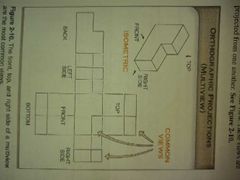
Multiview drawing, each surface is shown as a 2D |
|
|
|
Dimensions |
Numerical value that gives size, form or location of objects on prints |
|
|
|
What are common dimensions? |
Linear - measures lines in drawing coordinates Aligned - measures lines in plane of object Angular - measures angles |
|
|
|
What is tolerance? |
Amount of allowable variation either above or below a stated dimension |
|
|
|
Object line |
A line that defines the visible shape of an object, typically thick and dark |
|
|
|
Hidden lines |

Line that represents shapes that cannot be seen directly in that view, typically they are thin, dark and dashed lines |
|
|
|
Centerline |

A line that locates the center points of objects, arcs and circles, typically they are thin, dark and a series of long and short dashes |
|
|
|
Dimension lines |

lines used with dimensions to show size or location, typically they are thin and dark |
|
|
|
Extension lines |

A line that extends from surface features and terminates a dimension line |
|
|
|
Leader (drawings) |

A line that connects a dimension, note or specification with a particular feature of a drawn object |
|
|
|
Cutting plane line |

A line that shows where an object is images to be cut in order to see internal features |
|
|
|
Section lines |

Is a line that identifies the internal features of a part |
|
|
|
Break lines |

A line that can show internal features or avoid showing continuous features
Short - thick, dark and freehand squiggle Long - thin, dark line with zigzag at set intervals |
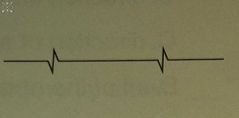
|
|
|
Surface feature |
Any part of the surface where change occurs |
|
|
|
Normal surface |
A plane surface parallel to a plane of projection |
|
|
|
Oblique surface |
A plane surface not parallel to any plane of projection |
|
|
|
Inclined surface |
A plane surface perpendicular to one plane of projection and inclined to the remaining 2 |
|
|
|
Intersecting surface |
Created anytime one surface meets another surface |
|
|
|
Through (thru) hole |

A drilled or punched hole passing completely through the material |
|
|
|
Blind hole |
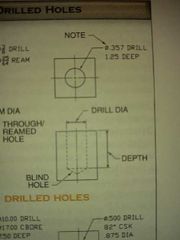
A drilled or punched hole that does not pass through the material |
|
|
|
Drilled hole |
Round hole in material produced by a twist drill |
|
|
|
Reaming (a hole) |
Enlarging and improving the surface quality of a hole |
|
|
|
Counter bored holes |
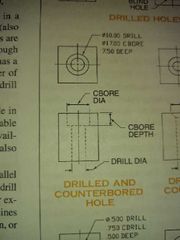
An enlarged and recessed hole with square shoulders |
|
|
|
Counter sunk holes |
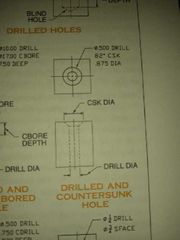
A hole with a cone shaped opening or recess at the outer surface |
|
|
|
Counter drilled holes |
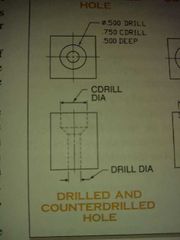
A hole with a cone shaped opening below the outer surface |
|
|
|
Spotfaces |
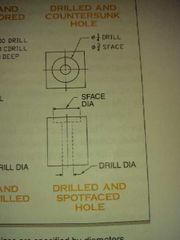
A flat surface machined at right angle to a drilled hole |
|
|
|
Edge |
Intersection of 2 surfaces |
|
|
|
Corner |
An angular space at the intersection of 2 surfaces |
|
|
|
Fillets and rounds |
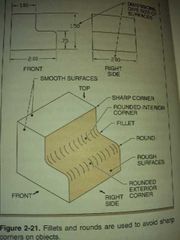
Fillet - rounded interior corner Round - rounded exterior corner |
|
|
|
Runout |

Curve produced by a plane surface tangent to a cylindrical surface |
|
|
|
Bevels and chamfers |

Bevel - sloped edge of an object running from surface to surface Chamfer - sloped edge of an object running surface to side |
|
|
|
Datum |
Is a point, line, axis or surface that serves as the origin for dimensions |
|
|
|
Feature |
Any surface, angle, hole, etc. which may be controlled on a part |
|
|
|
True or false: Dimensions of a drawing are given based on 68°F. |
True |
|
|
|
True or false: hole sizes are specified by their diameter |
True |
|

